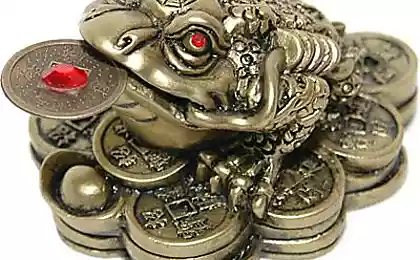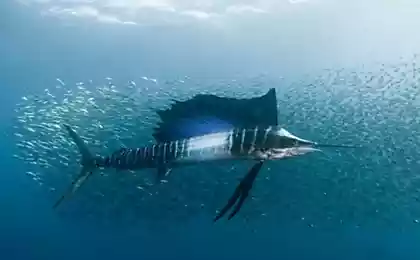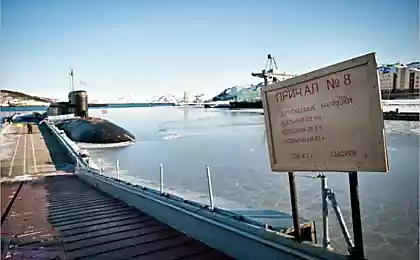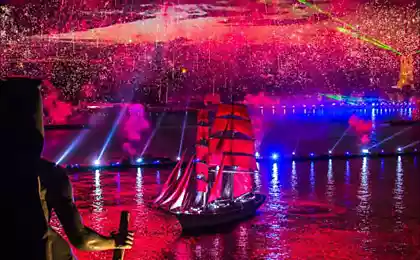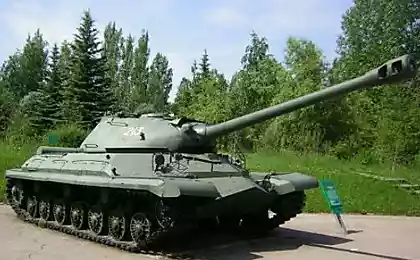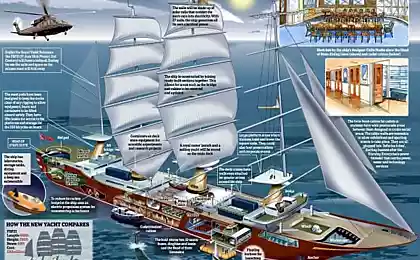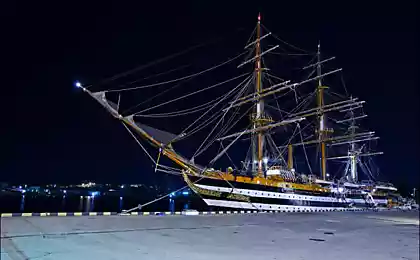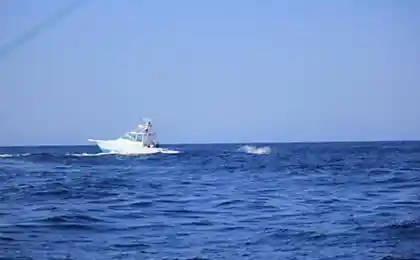4183
Two-masted sailboat with an oblique arms.
Sailor - always a sailor! and former naval officer Charles Easton Spooner (Charles Easton Spooner), forced in the middle of the 19th century to become a superintendent engineer and manager of one of the coastal NGR - their maritime skills are not forgotten. Being a sailor - he knew about the feature of onshore winds, about the morning and evening breezes, giving a smooth and predictable wind at certain hours.
Morning breezes blowing from the shore to the sea, in the evening on the contrary, and in general - on the beach complete calm rarity.
I very much wanted him to use this power, it is much nicer to slide under sail than straining at the oars rychagahdreziny! And since, as I said, had professional experience - it is simply built himself two-masted sailboat with an oblique arms.
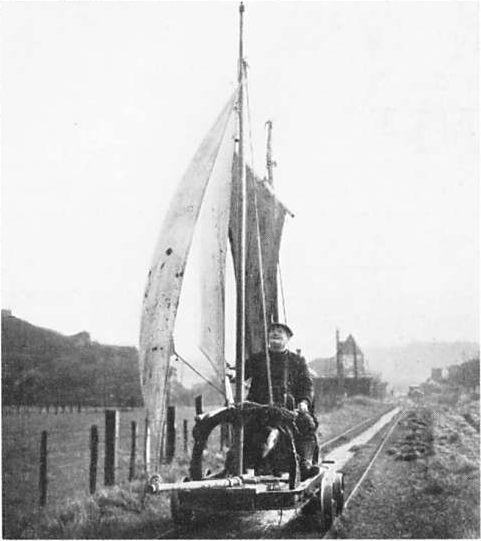
Such "boat" quickly spread around the coastal railway line where locals easily rolled on rails without waiting for the rare and very expensive trains. Who went and did not even every day - a leg on a boat a couple of tens of kilometers can be less than an hour in the absence of effort.
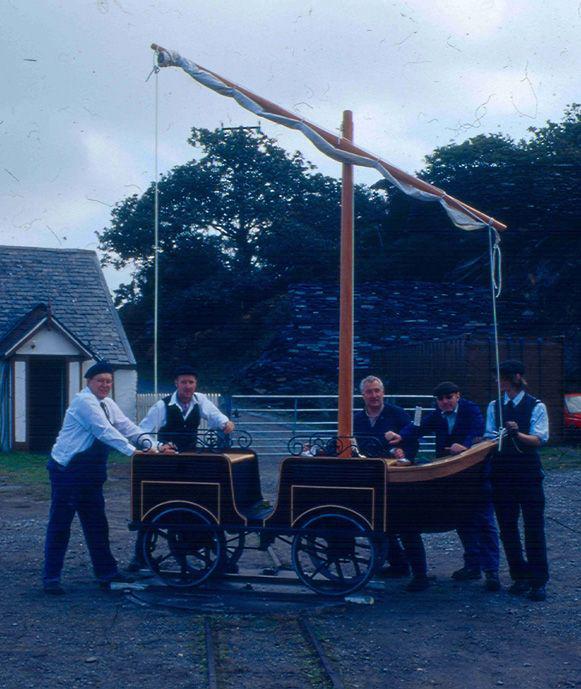

Delivery of passengers to the aircraft speed monorail track in any weather at a distance of 200-500 kilometers - an excellent idea. And if you look at the calendar and see there in 1965 - it becomes even more interesting. Nevertheless, it is. It is for the implementation of this idea was contracted engineer named Jean Bertin, who, that's what luck, undertook to implement the idea of Monsieur Louis Duthion, in 1961, patented the idea of high-speed train on hovercraft.
l'Aérotrain by Louis Duthion.
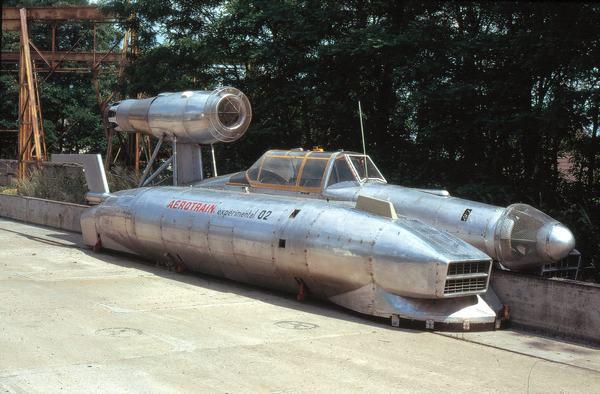
The result of this work was the second instance of the test apparatus AeroTrain №02 (the English version of the name), which is equipped with two engines of the destroyer. One in front of the machine, powered supercharger, and the second (rear pole) - engaged in a horizontal acceleration of the machine, hold tight rubberized rollers for the vertical part of the "rail».
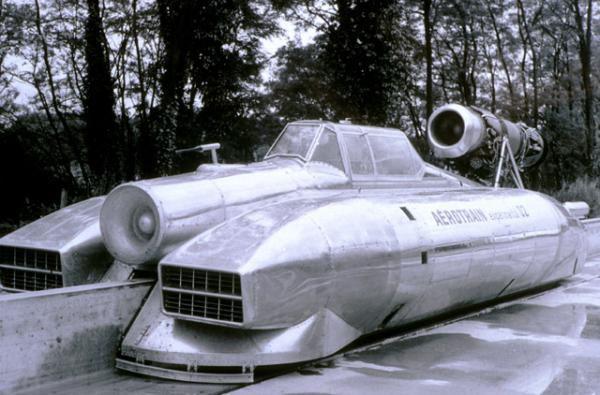
The effect was fully in line with expectations: January 22, 1969 l'Aérotrain 02 reached a speed of 422 km / h on the highway in Gometz-le-Châtel.
Success, in general, was full.
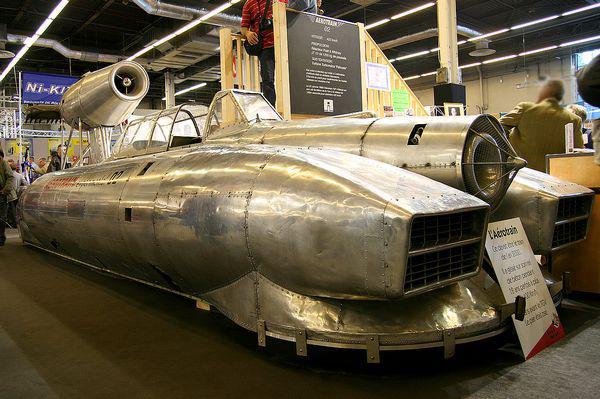
After such a demonstration in 1969 an experimental stretch of road 18 km was built in Rouen. This overpass extending to a height of five meters above the ground, supported by columns.

The line should be part of the future line Paris - Orleans. Straight lengths allowed to fly at a speed of 400 km / h. - Designer and started manufacturing is no longer a double "flying bomb", and a full passenger vehicle L'Aérotrain I80-250 «Orléans».
L'Aérotrain I80-250 «Orléans» turboprop with the installation.


L'Aérotrain I80 HV was already equipped with traction jet engines, and because they were located in the shaded part of the car - above the hull is now a special air intake for their food. And on jet-powered L'Aérotrain I80 HV, really flew. March 5, 1974, he set a new world record for land vehicles Class L, showing an average speed of 417, 6 km / h at a distance of 3 km and a maximum instantaneous speed was fantastic 430, 4 km / h.

L'Aerotrain I80 with a jet drive.


As such, the flying car was operated until 1976, when it signed a contract for a classic high-speed TGV train officials decided to roll the project in late 1974. Most of the tracks were dismantled, while the surviving portion of a memorial stone with a sign.
American engineer Joe V. Meigs patented and 1886 and built in Cambridge (Mass.), A full-scale model of the road to its construction. With original location rails - they are arranged one above the other. Not to fall - the train keeps track of the two sets of wheels: V-shaped pair of resting on the bottom rail and a pair of horizontal wheels resting on the sides of the upper rail. Despite the awkwardness of design - nice "bottle is" with unusual interior deftly ran on an experimental track length of about 400 meters.
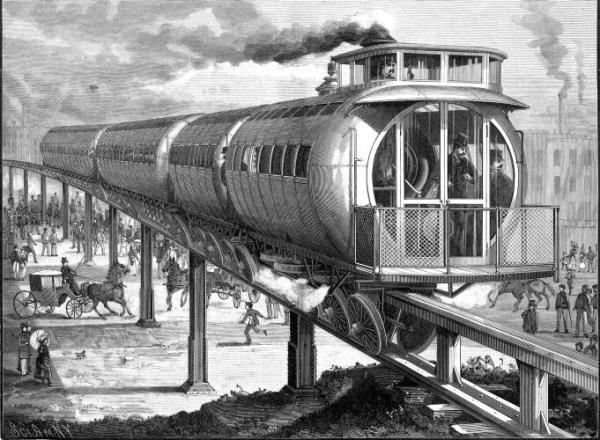

By the way, the engine was partitioned: trying to make my train as flexible as possible - Mace boiler placed in one trailer, and the steam engine itself - in another.

This monorail functioned properly eight years (!), Until 1894. But - as an attraction. Everyone looked, shook their heads, recognize that it's all just wonderful, newspapers printed laudatory essays - but nobody ordered Mace his way ...
It is difficult to understand what motivated balls and rollers inventor Eugene Fontaine from Detroit when he in 1881 at the plant «Grant Locomotive Works», in Paterson (NJ) collected pepelats. Formally, his argument sounded so that the "design will allow other things being equal a half times increase the speed of the locomotive." But how he was going to achieve this ???

However, if you look at the engraving, which has our contemporaries to finish the circumference of the wheel, it turns out that Mr. Fontaine portrayed so simple gear. Turnovers lead locomotive wheels about a half times and will be more than the speed of the steam engine. But why should it was necessary to enclose such enchanting design?

But, of course, the reality put everything in its place. Experimental operation showed that the locomotive inferior to their normal counterparts in absolutely everything, so to drive it for a while - the owners quickly converted it into a classic circuit with a normal drive wheels.
Designers Westinghouse in mid-1943 was created Steam turbine locomotive. Although the idea was to create this before. Steam turbine locomotive was used in this manual transmission with a tight coupling of turbine rpm and wheels.
Steam turbine locomotive S2. On the starboard side - the main traction turbine.

Decision, frankly, for the machine length 123 feet (with the tender) unconventional. But, of course, the efficiency of such a transmission to earn as high - but only in optimal conditions. And had to contrive to give the locomotive ability to move in reverse.
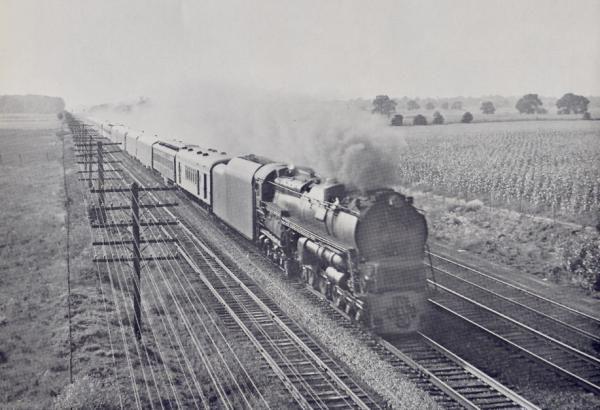
Create a reversible turbine can, of course - but it will be expensive and unreliable, so it was decided, in addition to the main turbine to put just one more, small, for reverse thrust.

The resulting Steam turbine locomotive built by Baldwin Locomotive Works was delivered to the customer, the company Pennsylvania Railroad. Maximum power parotutrbovoza S2 was quite sufficient, 6900l.s., Traction was smooth - and at high speed (maximum - more than 160 km / h) the composition of flying amazingly smoothly without jerking typical for locomotives caused by uneven torque of the steam engine.
In 1949 S2 Steam turbine locomotive was removed from the line.

Just three years he stood on the siding, and then, when the railroad finally convinced that the new generation of locomotives quite adequately perform its duties - in 1952 was sent to the smelter.
Look closely at this pepelats. You have no sense of self-made? If there is - it is absolutely correct. This machine - Frontline - more precisely, a rear improvisation wartime. Exhausted partisans German attack on the technical creativity, trying to counter the Soviet partisans iron monsters of various types. But, "firm" catastrophically lacked armor, all that could be done was taking the front, so that (the soldiers engaged in the protection of railways had to be "smart soldier»).
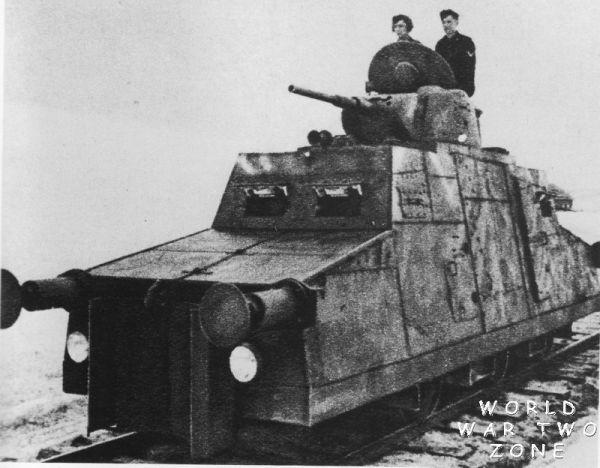
Partizanen! Partizanen!

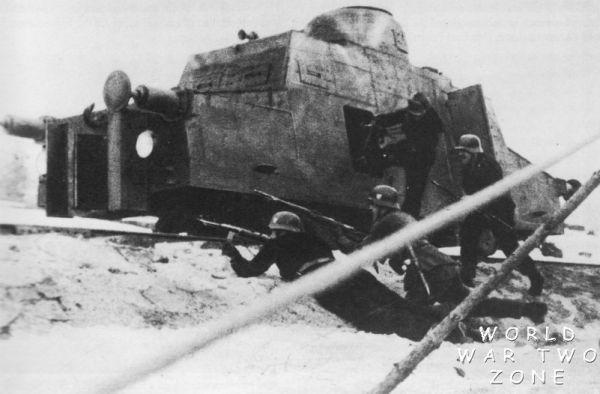
As soon as the armored train called "armadillos railways", then it must be assumed that every large ship there is a large torpedo. And indeed, in the prewar years in service with the Red Army consisted railway torpedoes ZHDT-3.

At the request of the Office of the Red Army armored "train torpedo" was developed by KB Podolsky Machine-Building Plant named after Ordzhonikidze in 1935. Issue has been launched torpedoes at the same factory in 1938. The total weight - 225 kg, including 100 kg of TNT was charged in an enclosure; was remote and contact fuses, two electric motors, two rechargeable batteries, the speed of the horizontal section of the railway path was 60 km / h, the range independent course is up to 10 km.
However, the effectiveness of these torpedoes are estimated at more than skeptical.
By the beginning of the Great Patriotic War in the Red Army still had 26 such torpedoes. 10 KOVO, 4 in Squaw, and 12 in the Far East (RSMA, p. 31811, Op. 2, d. 1195). Information on the combat application no,
The Germans did not have to reinvent the torpedoes, and produced puterazrushiteli Krupp in 1942 they were applied in the second half of 1943 for the destruction of railway track. The principle of operation combined: mechanical fault wooden sleepers and subgrade damage with subsequent logging rail lashes to pieces by undermining small explosive charges in the form of Tolowa Language checkers. Towed 1-2 locomotives.

Puterazrushitel consists of a railway platform with a special hook-shpalorazrushitelem and two or three cars for the service team. Puterazrushitelya team has a stock of explosives, anti-aircraft guns and machine guns. When you pull one or two locomotives puterazrushitel almost completely destroys the way with an average speed of 10 km per hour.

At the same time destroyed: 100% sleepers, rails - by 70-90% (interrupted explosive charges) and bonds - up to 30%.
In the Soviet Union also created puterazrushiteli. Puterazrushitel type "Loop" was used for the destruction of Soviet railroad RSHR (track panel) of the rails "light" types. Represent a pair of bent into a loop rails. Loop plant near the track panels, then both ends of the loop are attached to the locomotive. Locomotive pulls it behind him, shattering way.
The picture shows the tram puterazrushitel.
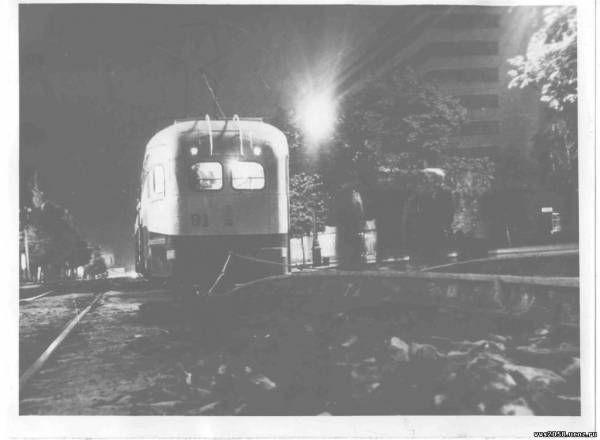
In 1889, a test line in the vicinity of New York under the auspices of the long Island Boynton Bicycle Railroad company came here is such a unique train. Design features is to use two rails. Lower and upper bearing supports.
Locomotive system Boynton Bicycle.

Monorail locomotive comes with a composition on Brighton beach.

Experienced tram "cycling" type.
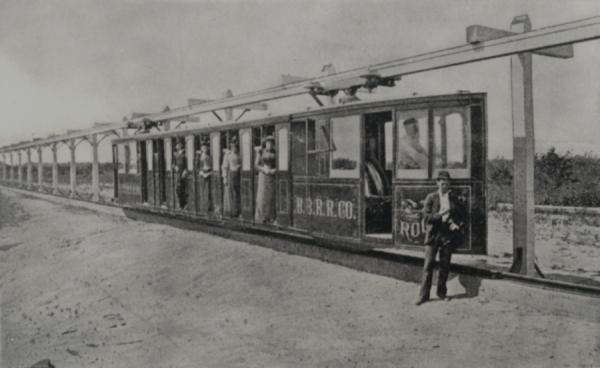
The idea of the construction of the Soviet Steam diesel hybrid locomotive goes back to 1935, when a student LM Meisel offer innovative design, which on the one hand allows to combine traction steam engine locomotive with the economy, and on the other - has been dead weight unused in one time or another machine. How can this be achieved? Pretty simple but original way - the same cylinder steam engine used alternately as steam or diesel. Moreover, it was subsequently implemented and combined mode.
Steam diesel hybrid locomotive №8000.

Locomotive starts moving like a classic steam train, and upon reaching the speed of 15-25km / h began injection of diesel fuel instead of steam in the middle cavity of a three-section of the cylinder. In this case, the steam flow rate is sharply reduced and the machine becomes very, very economical. Steam diesel hybrid locomotive of this type with serial number 8000 was built in Voroshilovgrad in September 1939. Already the first months of operation gave good results - Steam diesel hybrid locomotive was in average twice as economical base Steam Engine, and developing the capacity to 3000l.s. can run at speeds of up to 105km / h.
Upgraded Steam diesel hybrid locomotive 8001

However, all was not so rosy. Lokomotiv appeared peretyazhelen. Axle load of 25 tons at the time was excessive. Attempts to improve the design of radical success is not given, then the war started and was not up to the frills. Steam diesel hybrid locomotive regularly worked throughout the war, and was even improved in 1943: it was sold "dovpryskivanie" couple in diesel cylinder at the end of the stroke, which is slightly increased capacity.
However, the cure unit from all childhood diseases and failed, and here and Industry serial locomotives mastered so worked until 1948 this unique locomotive was decommissioned for scrap.
This unusual looking machine who just do not like to call - and the armored car, and bronedrezinoy and ram and an iron on the tracks and a sledgehammer - and opens a casket. In the left part of the photo is visible to the inscription on the car, which is in the background. See? «Canadian Nationa» ...

Well, that's otgadka - it is only a self-propelled blades to fight with snow on the w / e ways. A balanced - just for reasons of ease of use, not to deploy to and fro.
Morning breezes blowing from the shore to the sea, in the evening on the contrary, and in general - on the beach complete calm rarity.
I very much wanted him to use this power, it is much nicer to slide under sail than straining at the oars rychagahdreziny! And since, as I said, had professional experience - it is simply built himself two-masted sailboat with an oblique arms.

Such "boat" quickly spread around the coastal railway line where locals easily rolled on rails without waiting for the rare and very expensive trains. Who went and did not even every day - a leg on a boat a couple of tens of kilometers can be less than an hour in the absence of effort.


Delivery of passengers to the aircraft speed monorail track in any weather at a distance of 200-500 kilometers - an excellent idea. And if you look at the calendar and see there in 1965 - it becomes even more interesting. Nevertheless, it is. It is for the implementation of this idea was contracted engineer named Jean Bertin, who, that's what luck, undertook to implement the idea of Monsieur Louis Duthion, in 1961, patented the idea of high-speed train on hovercraft.
l'Aérotrain by Louis Duthion.

The result of this work was the second instance of the test apparatus AeroTrain №02 (the English version of the name), which is equipped with two engines of the destroyer. One in front of the machine, powered supercharger, and the second (rear pole) - engaged in a horizontal acceleration of the machine, hold tight rubberized rollers for the vertical part of the "rail».

The effect was fully in line with expectations: January 22, 1969 l'Aérotrain 02 reached a speed of 422 km / h on the highway in Gometz-le-Châtel.
Success, in general, was full.

After such a demonstration in 1969 an experimental stretch of road 18 km was built in Rouen. This overpass extending to a height of five meters above the ground, supported by columns.

The line should be part of the future line Paris - Orleans. Straight lengths allowed to fly at a speed of 400 km / h. - Designer and started manufacturing is no longer a double "flying bomb", and a full passenger vehicle L'Aérotrain I80-250 «Orléans».
L'Aérotrain I80-250 «Orléans» turboprop with the installation.


L'Aérotrain I80 HV was already equipped with traction jet engines, and because they were located in the shaded part of the car - above the hull is now a special air intake for their food. And on jet-powered L'Aérotrain I80 HV, really flew. March 5, 1974, he set a new world record for land vehicles Class L, showing an average speed of 417, 6 km / h at a distance of 3 km and a maximum instantaneous speed was fantastic 430, 4 km / h.

L'Aerotrain I80 with a jet drive.


As such, the flying car was operated until 1976, when it signed a contract for a classic high-speed TGV train officials decided to roll the project in late 1974. Most of the tracks were dismantled, while the surviving portion of a memorial stone with a sign.
American engineer Joe V. Meigs patented and 1886 and built in Cambridge (Mass.), A full-scale model of the road to its construction. With original location rails - they are arranged one above the other. Not to fall - the train keeps track of the two sets of wheels: V-shaped pair of resting on the bottom rail and a pair of horizontal wheels resting on the sides of the upper rail. Despite the awkwardness of design - nice "bottle is" with unusual interior deftly ran on an experimental track length of about 400 meters.


By the way, the engine was partitioned: trying to make my train as flexible as possible - Mace boiler placed in one trailer, and the steam engine itself - in another.

This monorail functioned properly eight years (!), Until 1894. But - as an attraction. Everyone looked, shook their heads, recognize that it's all just wonderful, newspapers printed laudatory essays - but nobody ordered Mace his way ...
It is difficult to understand what motivated balls and rollers inventor Eugene Fontaine from Detroit when he in 1881 at the plant «Grant Locomotive Works», in Paterson (NJ) collected pepelats. Formally, his argument sounded so that the "design will allow other things being equal a half times increase the speed of the locomotive." But how he was going to achieve this ???

However, if you look at the engraving, which has our contemporaries to finish the circumference of the wheel, it turns out that Mr. Fontaine portrayed so simple gear. Turnovers lead locomotive wheels about a half times and will be more than the speed of the steam engine. But why should it was necessary to enclose such enchanting design?

But, of course, the reality put everything in its place. Experimental operation showed that the locomotive inferior to their normal counterparts in absolutely everything, so to drive it for a while - the owners quickly converted it into a classic circuit with a normal drive wheels.
Designers Westinghouse in mid-1943 was created Steam turbine locomotive. Although the idea was to create this before. Steam turbine locomotive was used in this manual transmission with a tight coupling of turbine rpm and wheels.
Steam turbine locomotive S2. On the starboard side - the main traction turbine.

Decision, frankly, for the machine length 123 feet (with the tender) unconventional. But, of course, the efficiency of such a transmission to earn as high - but only in optimal conditions. And had to contrive to give the locomotive ability to move in reverse.

Create a reversible turbine can, of course - but it will be expensive and unreliable, so it was decided, in addition to the main turbine to put just one more, small, for reverse thrust.

The resulting Steam turbine locomotive built by Baldwin Locomotive Works was delivered to the customer, the company Pennsylvania Railroad. Maximum power parotutrbovoza S2 was quite sufficient, 6900l.s., Traction was smooth - and at high speed (maximum - more than 160 km / h) the composition of flying amazingly smoothly without jerking typical for locomotives caused by uneven torque of the steam engine.
In 1949 S2 Steam turbine locomotive was removed from the line.

Just three years he stood on the siding, and then, when the railroad finally convinced that the new generation of locomotives quite adequately perform its duties - in 1952 was sent to the smelter.
Look closely at this pepelats. You have no sense of self-made? If there is - it is absolutely correct. This machine - Frontline - more precisely, a rear improvisation wartime. Exhausted partisans German attack on the technical creativity, trying to counter the Soviet partisans iron monsters of various types. But, "firm" catastrophically lacked armor, all that could be done was taking the front, so that (the soldiers engaged in the protection of railways had to be "smart soldier»).

Partizanen! Partizanen!


As soon as the armored train called "armadillos railways", then it must be assumed that every large ship there is a large torpedo. And indeed, in the prewar years in service with the Red Army consisted railway torpedoes ZHDT-3.

At the request of the Office of the Red Army armored "train torpedo" was developed by KB Podolsky Machine-Building Plant named after Ordzhonikidze in 1935. Issue has been launched torpedoes at the same factory in 1938. The total weight - 225 kg, including 100 kg of TNT was charged in an enclosure; was remote and contact fuses, two electric motors, two rechargeable batteries, the speed of the horizontal section of the railway path was 60 km / h, the range independent course is up to 10 km.
However, the effectiveness of these torpedoes are estimated at more than skeptical.
By the beginning of the Great Patriotic War in the Red Army still had 26 such torpedoes. 10 KOVO, 4 in Squaw, and 12 in the Far East (RSMA, p. 31811, Op. 2, d. 1195). Information on the combat application no,
The Germans did not have to reinvent the torpedoes, and produced puterazrushiteli Krupp in 1942 they were applied in the second half of 1943 for the destruction of railway track. The principle of operation combined: mechanical fault wooden sleepers and subgrade damage with subsequent logging rail lashes to pieces by undermining small explosive charges in the form of Tolowa Language checkers. Towed 1-2 locomotives.

Puterazrushitel consists of a railway platform with a special hook-shpalorazrushitelem and two or three cars for the service team. Puterazrushitelya team has a stock of explosives, anti-aircraft guns and machine guns. When you pull one or two locomotives puterazrushitel almost completely destroys the way with an average speed of 10 km per hour.

At the same time destroyed: 100% sleepers, rails - by 70-90% (interrupted explosive charges) and bonds - up to 30%.
In the Soviet Union also created puterazrushiteli. Puterazrushitel type "Loop" was used for the destruction of Soviet railroad RSHR (track panel) of the rails "light" types. Represent a pair of bent into a loop rails. Loop plant near the track panels, then both ends of the loop are attached to the locomotive. Locomotive pulls it behind him, shattering way.
The picture shows the tram puterazrushitel.

In 1889, a test line in the vicinity of New York under the auspices of the long Island Boynton Bicycle Railroad company came here is such a unique train. Design features is to use two rails. Lower and upper bearing supports.
Locomotive system Boynton Bicycle.

Monorail locomotive comes with a composition on Brighton beach.

Experienced tram "cycling" type.

The idea of the construction of the Soviet Steam diesel hybrid locomotive goes back to 1935, when a student LM Meisel offer innovative design, which on the one hand allows to combine traction steam engine locomotive with the economy, and on the other - has been dead weight unused in one time or another machine. How can this be achieved? Pretty simple but original way - the same cylinder steam engine used alternately as steam or diesel. Moreover, it was subsequently implemented and combined mode.
Steam diesel hybrid locomotive №8000.

Locomotive starts moving like a classic steam train, and upon reaching the speed of 15-25km / h began injection of diesel fuel instead of steam in the middle cavity of a three-section of the cylinder. In this case, the steam flow rate is sharply reduced and the machine becomes very, very economical. Steam diesel hybrid locomotive of this type with serial number 8000 was built in Voroshilovgrad in September 1939. Already the first months of operation gave good results - Steam diesel hybrid locomotive was in average twice as economical base Steam Engine, and developing the capacity to 3000l.s. can run at speeds of up to 105km / h.
Upgraded Steam diesel hybrid locomotive 8001

However, all was not so rosy. Lokomotiv appeared peretyazhelen. Axle load of 25 tons at the time was excessive. Attempts to improve the design of radical success is not given, then the war started and was not up to the frills. Steam diesel hybrid locomotive regularly worked throughout the war, and was even improved in 1943: it was sold "dovpryskivanie" couple in diesel cylinder at the end of the stroke, which is slightly increased capacity.
However, the cure unit from all childhood diseases and failed, and here and Industry serial locomotives mastered so worked until 1948 this unique locomotive was decommissioned for scrap.
This unusual looking machine who just do not like to call - and the armored car, and bronedrezinoy and ram and an iron on the tracks and a sledgehammer - and opens a casket. In the left part of the photo is visible to the inscription on the car, which is in the background. See? «Canadian Nationa» ...

Well, that's otgadka - it is only a self-propelled blades to fight with snow on the w / e ways. A balanced - just for reasons of ease of use, not to deploy to and fro.
